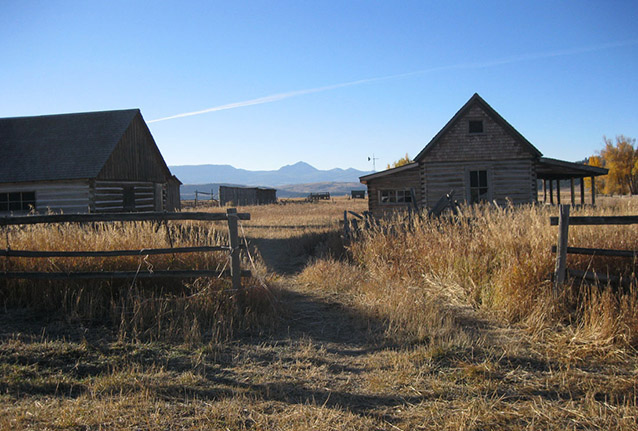Mormon Row
Mormon Row is an historic district located at the southeast corner of the Grand Teton National Park.
Leaders of The Church of Jesus Christ of Latter-day Saints sent members of the Church to establish new communities beyond the Salt Lake Valley. Several families settled east of Blacktail Butte in the late 1800s and clustered their farms close to the Gros Ventre River.
“James and Ann May migrated from Idaho over Teton Pass into Jackson Hole in July 1896, and claimed 160 acres under the Homestead Act of 1862, which promised that much land to any person willing to cultivate it for five years and build a house.”[1] Thirty more Latter-day Saints families established homesteads on “the rich soil along the Jackson-Moran Road, with agricultural fields stretching out away from the road behind each of the homesteads.”[2] These Mormon “line villages” were also popularly known as “Mormon Rows” throughout the west.[3]
“The nickname directly referred to the spatial organization of the villages, as well as the dominant religion they practiced. These small communities were built upon communal cooperation, sharing resources and workloads. Such cooperative land practices were based directly out of the Book of Mormon.”[4]
The settlers built ranches, a church, and a school. “In 1899 when the community was applying for a post office, the spelling changed to Grovont, as the United States Postal Service deemed “Gros Ventre” too hard to spell and pronounce. In an attempt to retain the original pronunciation, the homesteaders changed the spelling.”[5] Gros Ventre and Grovont were replaced by the nickname “Mormon Row,” which was initially intended to be derogatory.[6][7]
In Jackson Hole, the Mormons, or Latter-day Saints, faced several challenges unique to the valley. “First was the lack of building materials; lodgepole pine was the only available construction material. The first homes were all log cabins, and as time and money allowed, settlers would rebuild with more permanent materials. Mormon Row is one of the only places in the valley where stucco and wooden frame homes were constructed.”[8] One of the other challenges was the small acreage, which was primarily used to grow hay. “Many of the ranchers filed for additional plots under different homesteading acts, and many grazed their cattle up in the Gros Ventre Mountains.”[9]
In 1908, Andy Chambers, John Moulton, and T. A. Moulton established their homesteads and built homes and barns that are still photographed today. In 1927, the residents were granted a dependable water source. In 1943, the Jackson Hole National Monument was created by Executive Order. By the 1950s, the homesteaders sold their land to the National Park Service to become part of the expansion of Grand Teton National Park. John D. Rockefeller bought out all but one acre of Mormon Row and donated it to the U.S. park system. That one acre of privately owned land still exists, and descendants of Thomas Alma Moulton still live on the property with views of the Teton Range and their iconic barn.
Only six homesteads remain today. They are: Thomas Perry, Andy Chambers, Thomas Alma Moulton, John Moulton, and Thomas Murphy. These six homesteads are part of a multimillion-dollar renovation project to restore and preserve them, funded by the Grand Teton National Park Foundation ($3 million), a local Zions Bank branch ($25,000), and the National Park Service ($1.7 million), as well as other donations.
- John Moulton built the Pink House in the 1930s. “While John’s wife, Bartha, was in the hospital, John wanted to do something special to commemorate her homecoming,” according to the Jackson Hole Historical Society and Museum. “He knew that she had wanted to repaint the house, and due to a small mix-up, chose the salmon pink color. When Bartha came home, she despised the color but so loved the sentiment behind it that it was never changed.”[10]
In the 1950s, the families left, though Moulton remained till his death in 1990.
Mormon Row Historic District was added to the National Register of Historic Places in 1997 as an Historic District.


